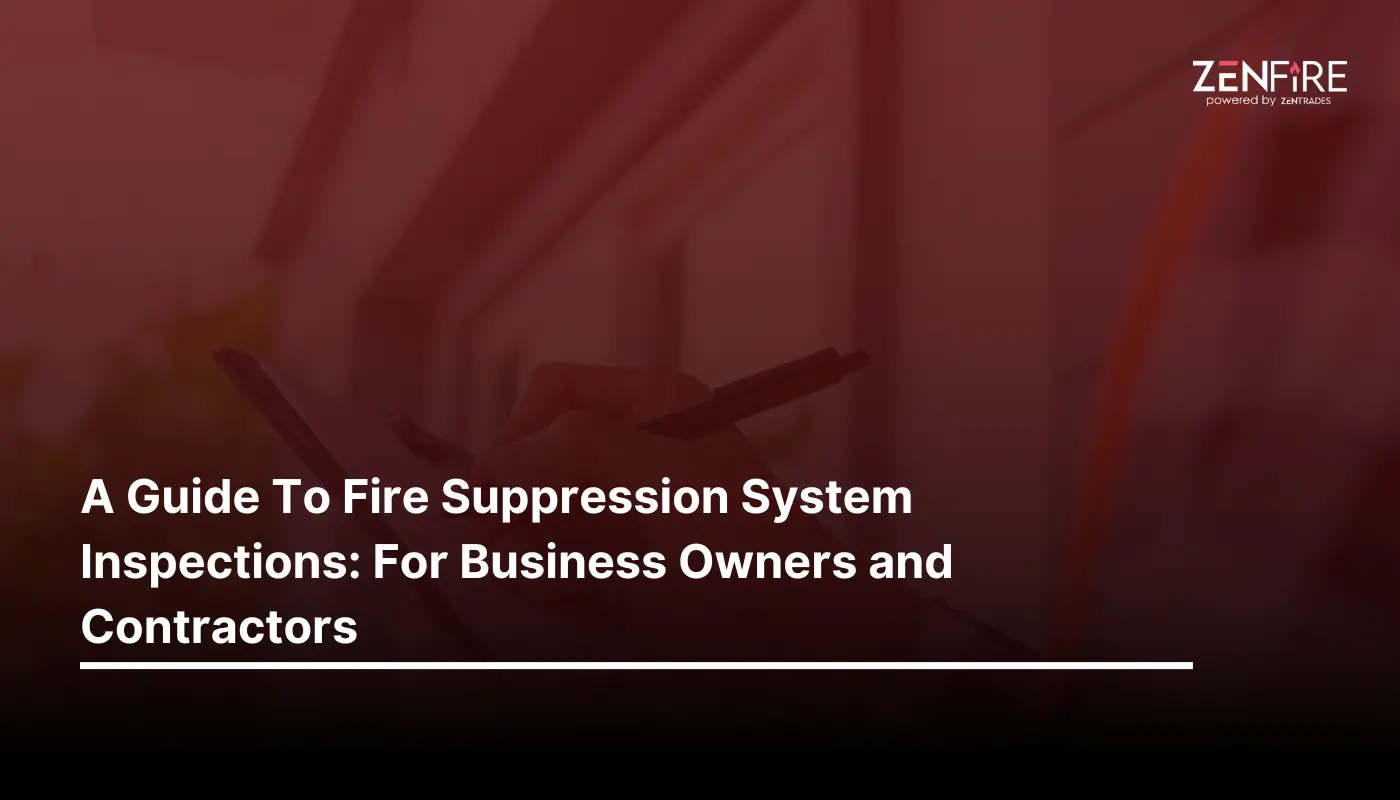A Guide To Fire Suppression System Inspections: For Business Owners and Contractors
- Field Service Management
- 3 Min Read
A fire suppression system is an essential component for enabling fire safety and safeguarding lives, businesses, and property. Whether for residential or commercial property, aircraft, or marine vessels, these fire protection systems help prevent and protect against serious fire hazards.
However, installing these fire protection systems is just half the way to protect yourself from the devastating effects of fire. You must also have proper inspection checks and regular maintenance of your fire protection systems and equipment to ensure they are in proper working condition and ready to help you in a crisis.
Hence, regular maintenance testing and fire suppression system inspections are imperative to ensure security and assurance against accidental fire.
Here What We Cover
Importance Of Fire Suppression System Inspection
Fire suppression system inspection is an important part of keeping your systems and equipment from malfunctioning in the time of need. They act as the first line of defense in protecting lives and preventing establishments from incurring severe damage. They are designed to help you detect, suppress, and prevent your belongings from catching fire.
The NFPA provides certain codes and regulations that business owners and safety inspectors must adhere to. These codes and regulations aim to minimize the risks and effects of fire hazards. Fire safety inspectors need to adhere to fire sprinkler inspection protocol while conducting inspections to prevent accidental fires, which can cause loss of lives and property damage. We have also created a guide on avoiding fire inspection mistakes, which is very useful for a business that works with teams..
Also, keeping your suppression system in proper working order is essential for keeping them ready to use anytime an emergency arises.
Not to mention, the cost of having your systems inspected is lower compared to the price you have to pay after the damage has been incurred. So, it’s always a better option to schedule your suppression system inspection at regular intervals and avoid unnecessary adversities.


Use our free estimate template now
Make winning quotes in minutes—for any industry and any job.
Components of a Fire Suppression System That Needs To Be Inspected And Tested
The components of a fire suppression system depend on its type and the specific hazards it is meant to combat. Nevertheless, all fire suppression systems comprise these basic features that work together to detect, suppress, and control fire spread.
Components:
Sensory System: This comprises smoke, heat, and flame sensors that help detect potential fires.
Suppression Agent Containers: This is where the suppression chemicals are stored. These chemicals are the primary components that aid in extinguishing fire by forming a frothy layer and halting combustion.
Duct System: These pathways dispense the chemical agents from the container to nozzles and sprinklers onto the affected areas.
Control System: The central unit where the suppression system receives signals and activates the system.
Alarm Systems: After detecting a possible fire, signals are sent to these units to alert occupants and commence evacuation.
These fire suppression systems are enabled with a backup power supply to control fire systems and maintain system operations even during power outages.
Apart from the above primary components, emergency exits and lights also play a significant role in ensuring fire safety and security by making the evacuation process effortless.
Testing And Inspection:
A trained and certified technician from your locality will conduct professional inspections of your fire suppression and sprinkler system testing records. It starts with visual inspections and fire sprinkler system testing, followed by functional testing of your suppression system.
Extinguishing agents: Safety professionals verify the quantity and pressure for signs of leakage or damage and analyze the chemical composition to ensure they are within the specified range and tolerance.
Sprinkler heads: If they have visible damage or obstruction, activate them for testing and ensure they discharge water or chemicals in the required flow for effective fire suppression.
Control panels check for proper functioning and errors, followed by activating the system for adequate response and activity. They also effectively monitor communication with other systems and, most importantly, inspect the battery status.
Alarms and detectors: Check for physical damage and proper installation, and activate the sensors to ensure they properly trigger signals and provide accurate indications. It also includes checking sensitivity levels to detect smoke at various thresholds.
Piping Pathways: inspected for corrosion or damage. Pressure testing to ensure valves can maintain the required pressure levels without failure. Open and close testing of control valves and water flow tests.
Emergency lighting and exits: This includes checking for bulbs or blocked visibility to ensure they work adequately, even during power outages.
How To Prepare For A Fire Suppression System Inspection
Before you schedule an appointment with a fire system inspection professional, you must perform these preliminary steps to ensure a smooth system inspection and process.
First, you must get acquainted with the local fire safety regulations and standards and the NFPA. These same fire codes and protocols mandate regular fire system inspections professional of fire suppression systems required fire system inspections.
Ensure you manually test your fire suppression system or by simulating fire and check for signs of damage or wear and tear.
Then, all fire suppression equipment and appliances should be shut down before the fire suppression inspection is processed, and access to the fire suppression system should be clear to avoid hindrances.
You need to make sure that the extinguishing system is in its correct location and that the area or equipment it covers hasn’t been changed or moved. Manual actuators need to be free from obstructions and in good working order. Tamper indicators and seals must be intact and maintenance tags or certificates have to be correctly attached.
Keep all necessary kitchen and fire suppression system documents handy, like maintenance reports, service records, or reports from previous inspections.
Finally, schedule an inspection appointment with a qualified safety inspector and get the process going.
Proper Way To Inspect A Fire Suppression System
Regular and proper inspection of your suppression components is essential to ensure that your system functions correctly and complies with the regulations of local fire codes and the National Fire Protection Association.
Depending on the system and local rules, fire suppression systems should be inspected annually or semiannually to avoid penalties and insurance coverage. Local building codes, fire safety regulations, and insurance requirements for fire suppression inspection must mandate monthly inspections.
Inspections will help you assess and check for visible damage, leaks, or any signs of wear and tear that could affect the system. They are followed by functional testing to ensure the components function properly as intended.
Live testing of components ensures they can withstand extreme situations in real-life situations, for example, pressure testing of valves and piping to detect the bandwidth required for
Always keep necessary documents handy, such as your inspection and maintenance records or actions taken to address issues during inspections.
In case of deficiencies identified, they must be addressed adequately through maintenance and repairs.
Get posts like this in your inbox.
Keep learning how to run a 5-star business with our bi-weekly newsletter.
How Often Does My Fire Suppression System Have To Be Inspected?
Your fire systems should undergo regular inspections and testing to enhance their effectiveness and maintain proper working conditions. If necessary, you can also conduct weekly or monthly inspections for your protection units.
Typically, fire suppression systems should be inspected semi-annually or annually. However, this can vary depending on local regulations, system type, or the area where they are installed.
Your local fire safety professional can help you with this. Consult him to determine your fire suppression system’s appropriate inspection schedule timeline.

Explore a better way to grow your business. Book a free demo now!
Get organized, win jobs, and wow customers.
Book A Free Demo with ZenTrades Today!
Related Reading
Why Your Field Software Management Software Needs QuickBooks Integration
ZenTrades Why Your Field Service Management Software Needs QuickBooks Integration Read More Request Demo...
Read MoreZenTrades How To Manage Electrical Service Agreements Like...
Read MoreZenTrades The Best 5 Jobber Alternatives In 2023...
Read More

